
 |
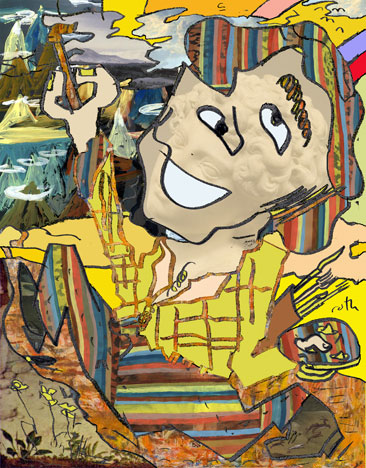
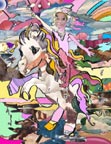 |
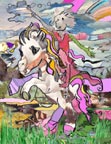 |
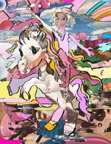 |
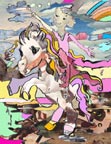 |
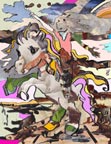 |
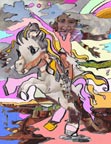 |
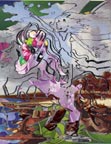 |
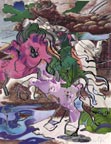 |
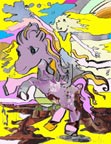 |
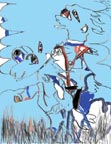 |
 |
 |
 |
 |
 |
 |
 |
 |
 |
 |
 |
 |
 |
 |
 |
 |
 |
 |
 |
 |
 |
 |
 |
 |
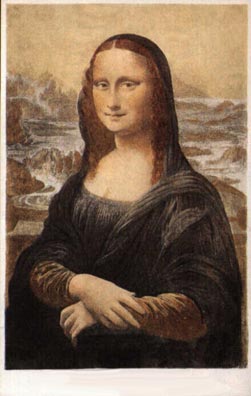
MoMA’s Dada exhibition (closing Sept. 11), provides the foundational pedestal for a work I’ve long sought to feature. In the great and auspicious tradition of Robert Rauschenberg’s Erased de Kooning Drawing (1953), Marcel Duchamp’s L.H.O.O.Q. (1919) and, of course, the generator of it all, Leonardo and his Mona Lisa (1503-1507)...I humbly request that the viewer consider today’s post an unmade readymade.
Update: Generous elucidation on this piece at HotLink. Thanks!
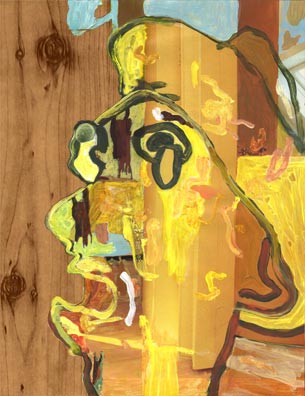
Key to the title's puzzle.
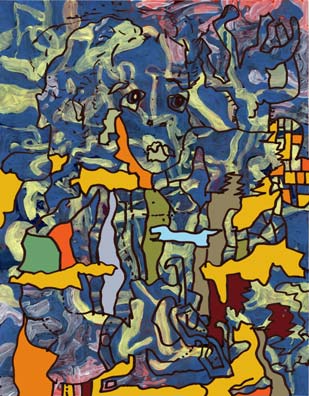
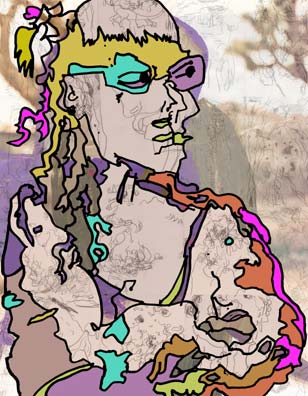
As the first Fall chill sweeps Manhattan, I'm still basking in the glow of our cursory survey of L.A.'s gallery scene. We were surprised by the warm receptions we received even in the midst of late August's art-scene-on-vacation atmosphere. There was good work and no shortage of kind assistance in negotiating the far flung gallery enclaves. Thanks to all those who were so generous with their time and knowledge.
Culver City has good work in focused spaces ensconced in stucco and aluminum siding. Blum and Poe's exhibition of Florian Maier-Aichen's subtly and digitally modified landscape photos were the highlight there. But Liz Oliveria's grad student show of lcd shadow boxes and photos, hidden in her delivery-side garage space off S. LaCienega, bore a charge echoing their industrial digs and revealed forthcoming promise.
Anna Helwing's summer group show offered several funky paintings by Lauren Lavitt whose unprescribed paint handling shifts focus of intent from inch to inch across the painting's surface as a means of holding everything together. Very satisfying. Her's seems like a joyful endeavor.
Then, there's the active transformation of Chinatown's Chung King Road into a two block bazaar of galleries - another example of art's capacity to find and utilize under-appreciated environmental niches. As a pedestrian New Yorker, it was right up my alley...(uh, hello, is this mic on?).
Many of the Chinatown galleries were on hiatus for the month. So, I don't presume to make an authoritative declaration on the matter - still, Black Dragon Society, China Art Objects and Peres Projects stand as particularly gratifying enterprises.
Our big event was a tattoo-packed, rollicking opening for Coop at Six Space. Six Space is the gleaming product of Chicago transplants Caryn Coleman and Sean Bonner, who also operate the website, art.blogging.la - a valuable resource for keeping apprised of the LA gallery scene.
Though they came highly recommended, timing and unaccountable vagaries precluded visits to Susanne Vielmetter, White Room and New Image Art (caps off to them for their recent NeckFace show - glad his work is now visible on both sides of the wall). Nonetheless, these and all the galleries above are now included in the gallery links page.
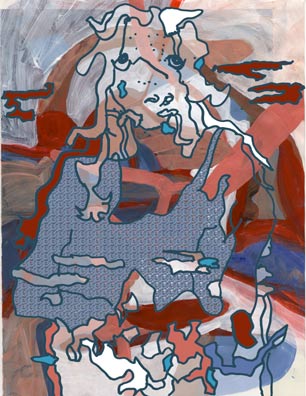
"It was one of the darker tunnels in Canada."
This vexing gem of an insight is a toss-away line proffered in Tom McCarthy's 2003 film, The Station Agent. Starring Peter Dinklage, Patricia Clarkson and Bobby Cannavale, the film is a measured jewel that I happened to run across this week.
Never a "spoiler," I did have one idiosyncratic reaction to the film (to which, my girlfriend was quick to quip, "Only a painter..."): Through much of the movie, I kept getting flashes of Giacometti, not so much the look of his sculptures, but the psychic feel they engender - the loneliness. (For those who've seen it, or will soon, I acknowledge the unintended irony in conflating the main character with the work of Giacometti).
Traditional readings of Giacometti's signature sculptures see his figures existing in a state of isolation, anxiety and unbridgeable individuation. Thus, it is fitting and ironic that Giacometti's work has an increasing power to lure people together. Throughout the 2001 MOMA Retrospective, his sculptures were often surrounded by standing room only crowds - people, ostensibly, gathered to collectively contemplate loneliness.
I've noticed the same dynamic drawing crowds at many recent films (The Hours, Igby Goes Down, Rushmore, Lost In Translation, Punch Drunk Love to name only a few). It would seem within our singularity resides our commonality. The Station Agent arrives at a similar conclusion, adding fraternal flesh to Giacometti's talismanic masterpieces.
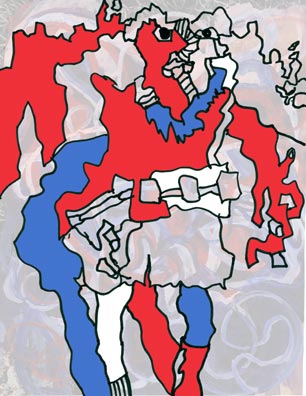
I was racking my brain in search of a concise, worthwhile post when I realized - as I always realize, eventually, in such circumstances - that it's the racking that causes the problem.
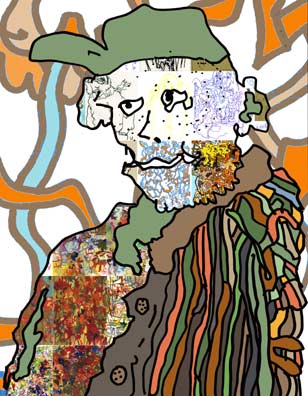
"so, so very what"
Stephen Jay Gould, and his zoologist colleague, Dr. Richard Lewontin, once famously proposed that the architectural structure known as a spandrel is an apt metaphor to explain certain features of evolution. The notion of a spandrel, they suggest, is applicable to structures exhibited by an organism which appear to confer no adaptive benefit. The authors maintain that it is a fallacy to attribute a purpose to every structure an organism manifests.
In a seminal essay, they conclude that the cathedral builders of old, after satisfying the engineering required to construct a cathedral's arches and domes, were left with unavoidable but structurally nonessential spaces, eventually known as spandrels. (Flat wall space created between two adjacent arches is one example).
In biological terms, one especially flamboyant example of a spandrel would be the male peacock's tail. This is nonessential in the extreme. Its size, weight and lack of utility imperil the bird's well-being and survival. Yet, the glorious tails are not eliminated by selective pressure because peacock hens, presumably, get the hots only for the most extravagantly gorgeous plumage.
It would appear that Beauty is the strange attractor of peacock evolution. Viewed this way, the survival of the peacock is the story of a genome in service to Beauty as an end.
The cathedral builders of Europe filled their spandrels with mosaics, frescoes and sculpture. What if the cathedral were thought of as a mere container for said mosaics and frescoes? Viewed this way, the architecture of the cathedral becomes an ingeneous adaptation arrived at in order to provide an opportunity for art to thrive. Beauty is the strange attractor.
The modern age might well turn out to be the artistic equivalent of the Cambrian Explosion - that era of volatile expansion about which Gould so lovingly wrote in his book, "Wonderful Life." Maybe the eruption of various innovative artistic practices in the 20th century - the avante garde, technological innovation, populism - parallel, in our own way, that grand epoch when Mother Nature was furiously at work creating the torrent of experimental forms which (530 million years later) would give us this world enriched with peacocks, cathedrals and theoretically-inclined biologists.
Art rises to fill the non-essential with Beauty and in so doing eliminates the very notion of irrelevance.
There are ripening spandrels aplenty in the artistic practice of our time: neo-paganism, virtual community and sustainablity. The selective pressures of environmental stress, commerce and mediated lcd (lowest common denominator) are accute. Yet, Beauty as guiding imperative remains unassailable.
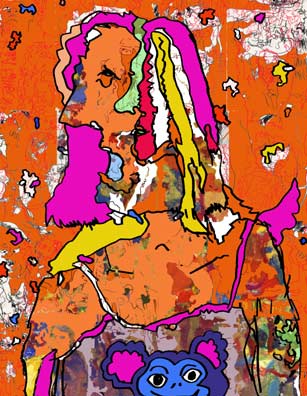
My experience finds it immaterial whether I do or do not begin a work with an intended destination in mind. Simply being attentive and moving the pencil or brush across the surface can bring forth images and resolutions I never ever could have anticipated (as was the case in 2002 when my life's work in Abstract Expressionism shifted to representational imagery seemingly out of the blue). Conversely, and invariably, in those instances when I do start off with a vision, the intended image is quickly (and happily) surrendered to process and rendered unrecognizable. In the end, the original guiding image is fulfilled in the prompt that first set the brush or pencil in motion. Thinking or not thinking, both can improve painting.
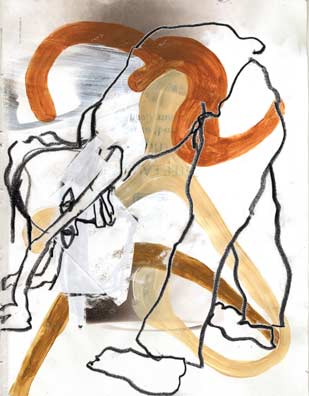
During my student days at the School of the Art Institute of Chicago, professor Dan Gustin once regaled the class with the story of European painting's first contact with the people of Japan. The Japanese response to seeing examples of the Great Western painting tradition was to ask, "why are their faces covered in mud?"
All that chiaroscuro, the flesh tones, brushing and perspective could - in a moment - be revealed as just one in an infinite number of ways to perceive and depict the world. To this day, I find the story compelling and it really hit the spot as a student.
The Japanese use the ground of the paper to represent flesh and the Europeans use the literal ground beneath their feet - pigments composed of pulverized rock and metal and so forth. Contemplating the mutability of reality is a profound pleasure.
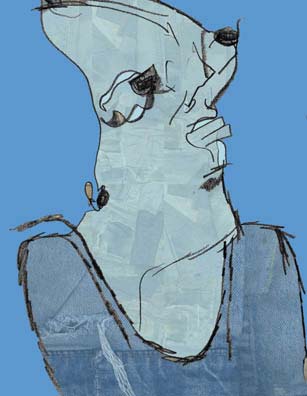
Initially, I was concerned to make this most recent painting THE Web debut. It's a bit of an aberration in the overall body of my work. This, though, begs the question: how can a control group thus far consisting of one item be perceived as aberrational? Maybe aberration will prove to be its own norm.